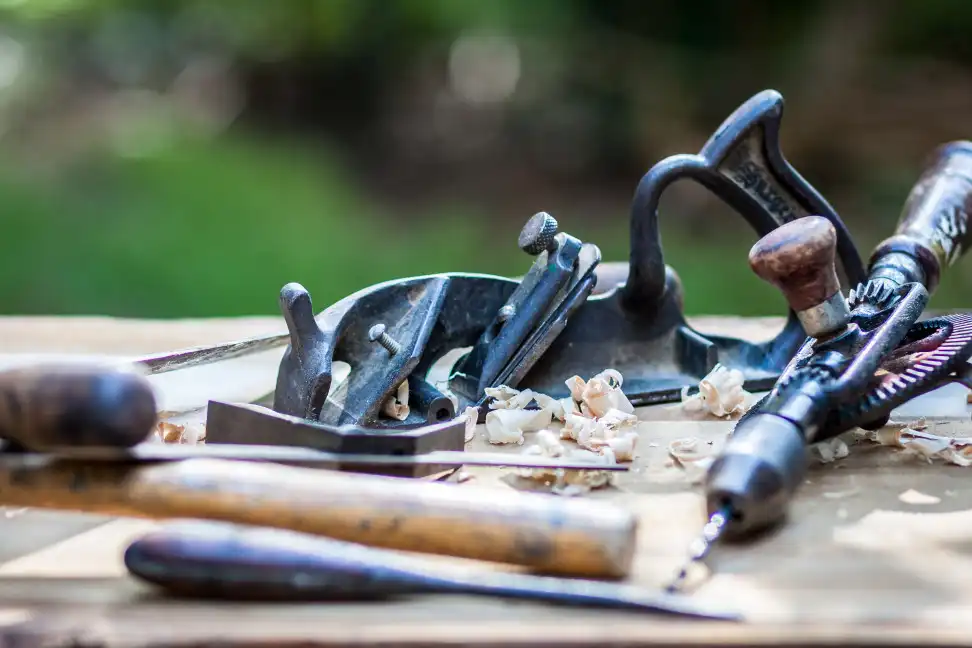What is a hand planer?
Planers are available in various sizes, from complete cabinet size planers to smaller benchtops and smaller handheld planers. Planers have blades or knives that revolve at high speeds in drums or tiny barrels. The wood is then pulled over the platform and through the blades by small wheels or rollers (the blades are on top, not the bottom). A set amount of wood is consistently removed from one side to the other as the wood passes between the blades, resulting in a completely flat and symmetrical board from front to back.

What is a belt sander?
A belt sander might be a tiny handheld or a bigger tabletop model. This belt includes sandpaper to remove small amounts of wood, evening out surfaces, paint, varnish, smoothing out characters, etc. Belt sanders have a looped large belt or strap, and they have a pretty powerful motor, often well over ten amps. In another way, this belt moves in a continuous motion, in a circle, at extremely high speeds of up to 3,000 surface feet per minute.
Belt sanders are excellent for smoothing and leveling out surfaces, primarily because they may utilize very coarse grit sandpaper, allowing for a rapid rate of wood removal. They are helpful both with and against the grain during sanding.

Difference between a hand planer and a belt sander
The essential distinction between the two types of woodworking equipment is that a belt sander sands away with sandpaper at the wood’s surface. In contrast, planers utilize massive blades to cut away at a specific depth in the wood with large blades. They are pretty different tools because of the difference in function.
- The Movement of Wood
Another difference between these two instruments, unless we’re talking about handheld planers, is that planers have rollers that pull the wood through the blades. In some instances, all you have to do is keep the wood steady while the planer does the rest.
On the other hand, Belt sanders do not have rollers that drive the wood through the machine, whether they are little manual sanders or big tabletop sanders. You must permanently move the sander over the wood.
- Purposes and Applications Expected
Perhaps the most significant distinction between these two instruments is their intended use. The goal of a planer is to smooth out and flatten wood to achieve a homogeneous surface. To put it across in another way, if you have a warped piece of wood, you can use the planer to cut away the warp (and any projecting portions) to create a perfectly squared and symmetrical composition. It’s all about maintaining flatness and consistency. Remember that planers are often suitable for long, flat boards.
Belt sanders, on the other hand, are best for smoothing out surfaces, evening out new additions (such as replacing a couple of floorboards), creating curves and shapes on nearly finished wood products, smoothing out rough edges, removing imperfections from wood surfaces, and removing things like paint, stain, and lacquer from wooden surfaces.
Similarities
- It’s possible to use it as a handheld or stationary device.
One of the most striking similarities between these two instruments functions as handheld or stationary devices. Large tabletop belt sanders and smaller portable belt sanders are available. On the other hand, full-size cabinet planers, small tabletop planers, and hand planers are all available (both manual and powered). Should you need something big and powerful or compact and portable, these tools come in a wide range of sizes and characteristics to meet your demands.
- Controlling Handheld Models Can Be Difficult
Another feature that both of these tools have in common is that the handheld ones can be difficult to handle; however, most people believe that the powerful belt sander is more challenging than a handheld planer. You can surely master either of them with practice.
They are capable of removing wood at high speeds.
Another thing these two instruments have in common is that they both excel at removing wood at fast speeds. Both tools rotate at a rate of several thousand times per minute. Due to the rapidity with which these tools operate, you must exercise extreme caution and precision when using them.
When to use a hand planer instead of a belt sander
If you need to straighten out a bent longboard or aren’t straight and flat, you’ll need to use a planer.
When to use a belt sander instead of a hand planer
A belt sander is what you need to form curves, smooth out a surface, remove rough edges, prepare a surface for painting, or even out a small surface.
Using a belt sander to plane
Sanders is used to smoothing off the edges of a plank or board. They can be used to smooth out and remove the surface of wood, but don’t expect to use one as a thickness planer.
When removing thickness with a sander, be careful not to damage your wood. You can harm a sander by using it as a wood planer to reduce viscosity and remove multiple layers of wood. Handheld models make numerous passes in a short period, and the friction and heat build-up can damage the sandpaper and fuses. You’ll have to replace sandpaper more frequently and expend more energy if you use it harshly.
Wood planers are your best friend for removing thickness and leveling out wood. They are valuable to eliminate layers of wood efficiently and safely while causing no damage to your boards. Planed boards attached from thicker boards or an overall single board thickness.
How to use an electric hand planer
- Always use the planer on a modest scale, only removing a skim at a time.
- Double-check that the path to the plane is clear and that there are no bumps or notches in the way of a seamless transition from beginning to end. If there are any, go over them first.
- Don’t anticipate your electric hand planer flattening and straightening your boards. They’ll follow the contour of the wood pretty closely, so you’ll have to skim off parts to make it flat manually.
- As you begin planning, shift your pressure to the back of the plane and let the blade do the work.
- An electric hand planer is not a jointer or a stationary thickness planer.
Electric hand planers are fantastic small instruments that may save time and effort if used correctly in the right circumstances. Even if the blade fully retracts, never lay a plane flat on its blade; instead, apply planes on their side or attach them to the base and angled away. It’s just an excellent habit to develop.
Belt sander or planer for doors
A belt sander is a perfect ideal tool for planning the door. Because of the coarse texture of the belt, it removes wood quickly and leaves an even finish. A planer is helpful if you need to smooth out a long wooden board quickly. On the other hand, a wide belt sander is an excellent investment if you want to remove coatings or make a surface smoother. Although an electric planer is technically possible, belt sanders are less expensive.
Hand plane sander
A wood planer out wood to an exact thickness, whereas sanders change the finish of the wood. Planers make even-thickness boards. You can use a planer to level multiple uneven pieces of wood to the same uniform thickness.
Wide belt sander vs planer
The main distinction between wide belt sanders and planers is that broad belt sanders sand surfaces with an abrasive belt, whereas planers use blades. Each machine produces a smoother texture, but their methods are vastly different.
Planers may cut quite profoundly into hardwood boards, whereas sanders remove only the surface. If you need to eliminate a lot of material from your workpiece, a planer will usually make the job go much faster. A wide belt sander can take anywhere from two to thirty passes to clear the same amount of material that a planer can eliminate in one pass.
- Pyrography Techniques for Beginners: Textures and Shading - January 23, 2024
- Troubleshooting Jointer Issues: Why is Your Jointer Not Flattening Wood? - October 11, 2023
- Unlocking the Secrets of Jointing to Increase Width - September 29, 2023